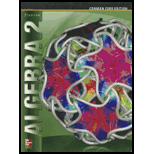
Concept explainers
a.
To make a table to show the expected length of Audrey’s hair in each of first 4 years
a.
Answer to Problem 55STP
The table for the expected length of Audrey’s hair in each of first 4 years is
| Year | Length |
| In 1st year | 10 inches |
| In 2nd year | 13 inches |
| In 3rd year | 16 inches |
| In 4th year | 19 inches |
Explanation of Solution
Given information:
Audrey’s hair is 7 inches long and is expected to grow at an average rate of 3 inches per year
Audrey’s hair grow 3 inches per year so,
After 1 year its length will be =
After 2 years its length will be =
After 3 years its length will be =
After 4 years its length will be =
The table for the length Audrey’s hair can be obtained as,
| Year | Length |
| In 1st year | 10 inches |
| In 2nd year | 13 inches |
| In 3rd year | 16 inches |
| In 4th year | 19 inches |
Therefore, the table is for length of Audrey’s hair of first 4 years is obtained
b.
To write the function that can be used to determine the length of Audrey’s hair after each year
b.
Answer to Problem 55STP
The function that can be used to determine the length of Audrey’s hair after each year is
Explanation of Solution
Given information:
Audrey’s hair is 7 inches long and is expected to grow at an average rate of 3 inches per year
Since Audrey’s hair is 7 inches long and expected to grow 3 inches every year so its expression can be written as,
Here,
Therefore, the obtained function is
c.
To determine the length of Audrey’s hair after 9 years if she does not get a hair cut
c.
Answer to Problem 55STP
The length of Audrey’s hair after 9 years will be 34 inches
Explanation of Solution
Given information:
Audrey’s hair is 7 inches long and is expected to grow at an average rate of 3 inches per year
Each year Audrey’s hair is expected to grow 3 inches so length of her hair after 9 years can be obtained as,
After 1 year its length will be =
After 2 years its length will be =
After 3 years its length will be =
After 4 years its length will be =
After 5 years its length will be =
After 6 years its length will be =
After 7 years its length will be =
After 8 years its length will be =
After 9 years its length will be =
Therefore, the length of Audrey’s hair after 9 years will be 34 inches
Chapter 8 Solutions
Glencoe Algebra 2 Student Edition C2014
Additional Math Textbook Solutions
Basic Business Statistics, Student Value Edition
Elementary Statistics: Picturing the World (7th Edition)
Elementary Statistics (13th Edition)
Intro Stats, Books a la Carte Edition (5th Edition)
- Problem #5 Suppose you flip a two sided fair coin ("heads" or "tails") 8 total times. a). How many ways result in 6 tails and 2 heads? b). How many ways result in 2 tails and 6 heads? c). Compare your answers to part (a) and (b) and explain in a few sentences why the comparison makes sense.arrow_forwardA local company has a 6 person management team and 20 employees. The company needs to select 3 people from the management team and 7 employees to attend a regional meeting. How many different possibilities are there for the group that can be sent to the regional meeting?arrow_forwardI have 15 outfits to select from to pack for my business trip. I would like to select three of them to pack in my suitcase. How many packing possibilities are there?arrow_forward
- There are 15 candidates running for any of 5 distinct positions on the local school board. In how many different ways could the 5 positions be filled?arrow_forwardCelina is picking a new frame for a custom piece of artwork. She has to select a frame size, material, and color. There are four different frame sizes, three different frame materials, and six different frame colors. She must chose one option only from each category. How many different possible frames could Celina pick from?arrow_forwardA research study in the year 2009 found that there were 2760 coyotes in a given region. The coyote population declined at a rate of 5.8% each year. How many fewer coyotes were there in 2024 than in 2015? Explain in at least one sentence how you solved the problem. Show your work. Round your answer to the nearest whole number.arrow_forward
 Algebra and Trigonometry (6th Edition)AlgebraISBN:9780134463216Author:Robert F. BlitzerPublisher:PEARSON
Algebra and Trigonometry (6th Edition)AlgebraISBN:9780134463216Author:Robert F. BlitzerPublisher:PEARSON Contemporary Abstract AlgebraAlgebraISBN:9781305657960Author:Joseph GallianPublisher:Cengage Learning
Contemporary Abstract AlgebraAlgebraISBN:9781305657960Author:Joseph GallianPublisher:Cengage Learning Linear Algebra: A Modern IntroductionAlgebraISBN:9781285463247Author:David PoolePublisher:Cengage Learning
Linear Algebra: A Modern IntroductionAlgebraISBN:9781285463247Author:David PoolePublisher:Cengage Learning Algebra And Trigonometry (11th Edition)AlgebraISBN:9780135163078Author:Michael SullivanPublisher:PEARSON
Algebra And Trigonometry (11th Edition)AlgebraISBN:9780135163078Author:Michael SullivanPublisher:PEARSON Introduction to Linear Algebra, Fifth EditionAlgebraISBN:9780980232776Author:Gilbert StrangPublisher:Wellesley-Cambridge Press
Introduction to Linear Algebra, Fifth EditionAlgebraISBN:9780980232776Author:Gilbert StrangPublisher:Wellesley-Cambridge Press College Algebra (Collegiate Math)AlgebraISBN:9780077836344Author:Julie Miller, Donna GerkenPublisher:McGraw-Hill Education
College Algebra (Collegiate Math)AlgebraISBN:9780077836344Author:Julie Miller, Donna GerkenPublisher:McGraw-Hill Education





